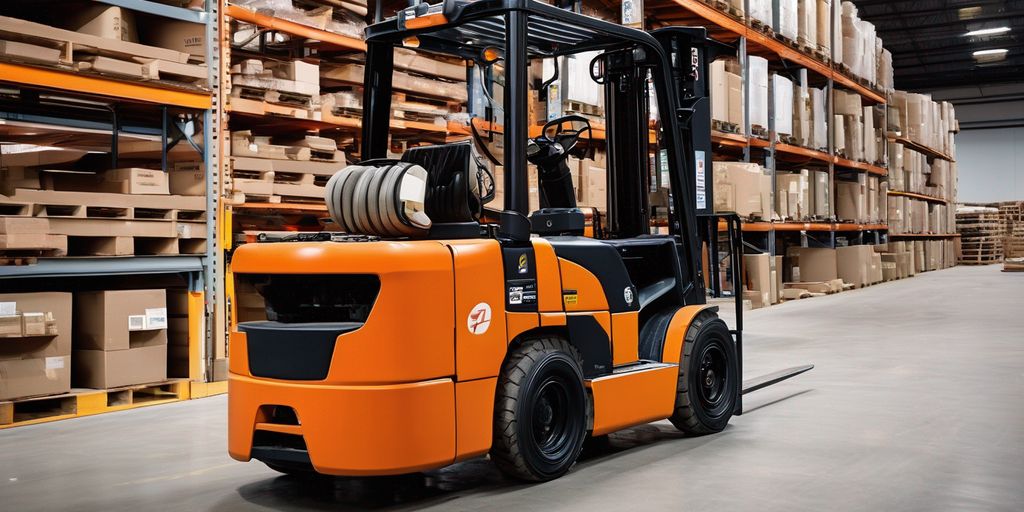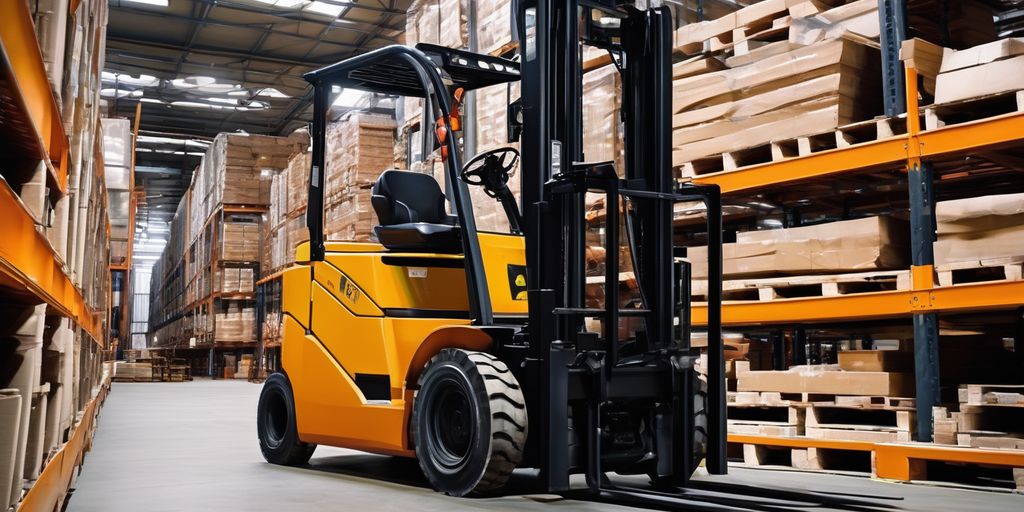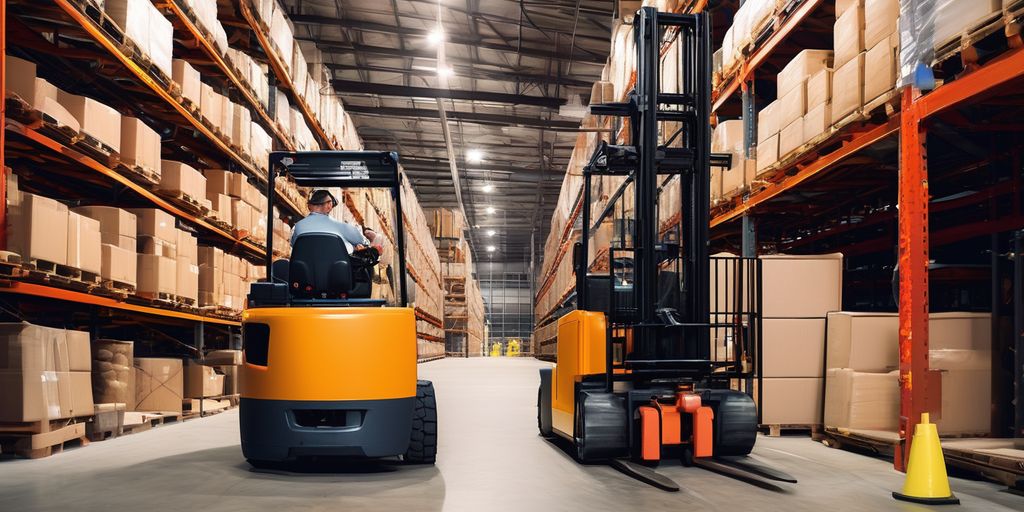Vender una carretilla elevadora, especialmente una usada, puede ser una tarea desalentadora. Sin embargo, con el enfoque y el conocimiento adecuados, puede garantizar una venta exitosa y rentable. Esta guía completa está diseñada para ayudarlo a navegar el proceso, desde comprender el mercado hasta manejar las consideraciones posteriores a la venta. Ya sea que sea un vendedor experimentado o nuevo en el mundo de los montacargas, esta guía le brindará información valiosa y consejos prácticos para que su proceso de venta sea fluido y eficiente.
Conclusiones clave
- Comprenda las tendencias actuales del mercado y las demandas estacionales para establecer un precio competitivo para su montacargas.
- Inspeccione, repare y limpie minuciosamente su montacargas para mejorar su atractivo y valor.
- Cree una lista atractiva y aproveche los mercados en línea y las redes sociales para lograr un marketing eficaz.
- Esté preparado para negociar con compradores potenciales comprendiendo sus inquietudes y destacando las características clave de su montacargas.
- Garantice un proceso de transacción fluido preparando la documentación necesaria, asegurando los métodos de pago y organizando la recogida o entrega.
Comprender el mercado de montacargas usados
La compra de carretillas elevadoras usadas es una decisión estratégica que puede beneficiar significativamente la eficiencia y los resultados de su empresa. Si evalúa cuidadosamente sus necesidades, establece un presupuesto, compra equipos usados de distribuidores de confianza, realiza inspecciones exhaustivas y tiene en cuenta factores como el medio ambiente y la certificación, podrá desenvolverse con confianza en el mercado de carretillas elevadoras usadas.
Preparando su montacargas para la venta
Vender un montacargas requiere una preparación cuidadosa para garantizar que se obtenga el mejor precio posible y atraer compradores serios. A continuación se detallan algunos pasos esenciales para preparar su montacargas para la venta.
Realizando una Inspección Exhaustiva
Es fundamental realizar una inspección exhaustiva. Examine el estado de la carretilla elevadora, incluidos el motor, el sistema hidráulico, los neumáticos, los frenos y el mástil. Solicite registros de mantenimiento para evaluar el cuidado que se le ha dado a la carretilla elevadora en el pasado. Inspeccione las horquillas y los accesorios para detectar desgaste y daños, ya que estos componentes son fundamentales para la manipulación segura de las cargas.
Reparaciones y Mantenimiento Necesarios
Realice las reparaciones y el mantenimiento necesarios antes de poner a la venta su carretilla elevadora. Esto incluye reparar cualquier problema mecánico, reemplazar piezas desgastadas y asegurarse de que la carretilla elevadora cumpla con los estándares de seguridad y rendimiento. Verifique las etiquetas de certificación que indiquen el cumplimiento de las regulaciones, como las pautas de OSHA.
Consejos de limpieza y presentación
Las primeras impresiones importan. Limpie a fondo su montacargas, eliminando la suciedad, la grasa y la mugre. Preste atención tanto al exterior como al interior, incluida la cabina del operador. Una carretilla elevadora bien presentada no sólo parece más atractiva, sino que también sugiere que ha recibido un buen mantenimiento. Considere aplicar una nueva capa de pintura si es necesario para mejorar su atractivo visual.
Al considerar los factores anteriores, no solo se asegura de obtener una buena relación calidad-precio, sino también un caballo de batalla confiable que servirá a su negocio durante años.
Establecer el precio correcto para su montacargas
Evaluando el Valor de Mercado
Antes de fijar un precio, es fundamental evaluar el valor de mercado de su carretilla elevadora. Utilice recursos en línea y publicaciones del sector para reunir información precisa sobre precios. Esto le ayudará a comprender el valor justo de mercado del modelo específico de carretilla elevadora usada y su estado. Con este conocimiento, puede negociar un precio justo que se ajuste a su presupuesto.
Considerando la depreciación
La depreciación es un factor importante a la hora de fijar el precio de su montacargas. Las carretillas elevadoras, al igual que el resto de maquinaria, pierden valor con el tiempo. Considere la edad, el uso y el estado general de su montacargas. Una carretilla elevadora en buen estado se depreciará más lentamente que una que haya sido descuidada.
Ofreciendo Precios Competitivos
Para atraer a posibles compradores, sus precios deben ser competitivos. Investigue modelos similares y sus precios en el mercado. Establezca un presupuesto realista que tenga en cuenta no solo el precio de compra, sino también los posibles costos de mantenimiento y reparación. Si bien las carretillas elevadoras usadas tienen un precio inicial más bajo, tener en cuenta los gastos continuos garantiza una visión integral de la inversión.
Fijar el precio correcto no se trata sólo de cubrir los costes sino también de hacer que la oferta sea atractiva para los compradores. Una carretilla elevadora a buen precio se venderá más rápido y de forma más eficiente.
Estrategias de marketing efectivas
Elaborando un Listado Atractivo
Crear un anuncio atractivo es fundamental para atraer a posibles compradores. Resalte las características principales de su carretilla elevadora, como su estado, antigüedad y cualquier mantenimiento o reparación reciente. Utilice un lenguaje claro y de alta calidad para describir las capacidades y los beneficios de la carretilla elevadora. Incluir especificaciones detalladas e imágenes de alta resolución puede mejorar significativamente el atractivo de su anuncio.
Utilizando Mercados en Línea
Los mercados en línea son una herramienta poderosa para llegar a una audiencia amplia. Plataformas como eBay, Craigslist y sitios web de venta de equipos especializados pueden ayudarle a conectarse con compradores que buscan carretillas elevadoras usadas. Asegúrese de que su listado esté optimizado con palabras clave relevantes para mejorar la visibilidad. Actualice periódicamente su listado para mantenerlo actualizado y atractivo.
Aprovechando las redes sociales
Las plataformas de redes sociales ofrecen oportunidades únicas para promocionar su montacargas. Comparta su anuncio en plataformas como Facebook, LinkedIn e Instagram para llegar a un público más amplio. Utilice anuncios dirigidos para llegar a grupos demográficos específicos interesados en equipos de manipulación de materiales. Interactuar con compradores potenciales a través de comentarios y mensajes también puede generar confianza y facilitar las ventas.
Los esfuerzos de marketing consistentes y estratégicos pueden aumentar significativamente sus posibilidades de vender su montacargas rápidamente y a un precio competitivo.
Negociando con Compradores Potenciales
Entendiendo las preocupaciones del comprador
Al negociar con compradores potenciales, es fundamental comprender sus principales inquietudes. Los compradores suelen preocuparse por el estado de la carretilla elevadora , su historial de mantenimiento y cualquier posible problema oculto. Aborde estas inquietudes desde el principio para generar confianza y facilitar un proceso de negociación más fluido.
Destacando Características Clave
Enfatice las características y beneficios clave de su montacargas. Resalte aspectos como pocas horas de funcionamiento, mantenimiento reciente y cualquier componente actualizado. Proporcionar información detallada puede ayudar a justificar el precio de venta y hacer que su montacargas sea más atractivo para los compradores.
Cerrando el trato con éxito
Para cerrar el trato con éxito, prepárese para negociar el precio y las condiciones. La flexibilidad a menudo puede conducir a una venta más rápida . Considere ofrecer incentivos como entrega gratuita o una garantía a corto plazo para endulzar el trato. El objetivo es asegurar un acuerdo mutuamente beneficioso , asegurando que ambas partes se sientan satisfechas con la transacción.
Recuerde, el proceso de negociación no se trata sólo de precio sino también de abordar las inquietudes del comprador y resaltar el valor de su montacargas.
Manejo del Proceso de Transacción

Preparando Documentación
La documentación adecuada es fundamental para que la transacción se lleve a cabo sin problemas. Asegúrese de tener todos los documentos necesarios, incluida la factura de venta , los registros de mantenimiento y toda la información de garantía . Esto no solo genera confianza con el comprador, sino que también lo protege legalmente.
Métodos de pago seguros
Cuando se trata de pago, la seguridad es primordial. Opte por métodos de pago seguros, como transferencias bancarias o servicios de depósito en garantía. Evite aceptar cheques personales o efectivo para minimizar el riesgo de fraude.
Organizando la recogida o entrega
Coordinar con el comprador para organizar la recogida o entrega del montacargas. Asegúrese de discutir y acordar la logística de antemano para evitar malentendidos. Si ofrece entrega, asegúrese de que el montacargas esté cargado y transportado de manera segura.
Un proceso de transacción bien organizado no sólo garantiza una venta fluida sino que también mejora su reputación como vendedor confiable.
Consideraciones Post-Venta
Proporcionando soporte postventa
Ofrecer un excelente servicio posventa es fundamental para mantener una buena relación con el comprador. Esto puede incluir responder cualquier pregunta que pueda tener sobre el funcionamiento de la carretilla elevadora, ofrecer orientación sobre el mantenimiento y estar disponible para cualquier necesidad de resolución de problemas.
Manejo de Devoluciones o Quejas
Manejar devoluciones o quejas de manera eficiente puede afectar significativamente su reputación como vendedor. Asegúrese de contar con una política de devoluciones clara y esté preparado para abordar cualquier problema que surja con prontitud. Esto no sólo ayuda a resolver conflictos sino que también genera confianza con sus compradores.
Recopilación de comentarios de clientes
Recopilar comentarios de los clientes es fundamental para mejorar sus futuros procesos de ventas . Considere la posibilidad de hacer preguntas a sus compradores como:
- ¿Cuánto tiempo hace que es cliente nuestro?
- ¿Consiguió la carretilla elevadora adecuada para su aplicación como resultado de nuestra consulta?
- ¿Hubo algún problema con la compra inicial?
- ¿El vendedor ha respondido a sus consultas posteriores a la compra?
- ¿El vendedor ha hecho un buen trabajo con el mantenimiento y las reparaciones? ¿Qué opinas de su plan de servicio?
- ¿Comprarías de nuevo a este vendedor?
- ¿Qué podría mejorar el vendedor en su funcionamiento?
Considere el valor de reventa del montacargas al recopilar comentarios, ya que puede proporcionar información sobre la satisfacción a largo plazo de sus clientes.
Conclusión
Vender una carretilla elevadora con éxito requiere un enfoque estratégico, una preparación exhaustiva y un profundo conocimiento del mercado. Si sigue los pasos descritos en esta guía, podrá asegurarse de presentar su montacargas de la mejor manera posible, atraer compradores serios y obtener un precio justo. Recuerde, la clave para una venta exitosa radica en la transparencia, la documentación detallada y un marketing eficaz. Ya sea que esté actualizando su equipo o simplemente esté buscando liquidar activos, esta guía completa le brinda el conocimiento y las herramientas necesarias para navegar el proceso de venta con confianza. ¡Feliz venta!
Preguntas frecuentes
¿Cómo puedo determinar el precio correcto para mi carretilla elevadora usada?
Evaluar el valor de mercado, considerar la depreciación y ofrecer precios competitivos son pasos esenciales para fijar el precio correcto para su montacargas usado.
¿Cuáles son algunas marcas y modelos populares de montacargas a considerar?
Las marcas populares incluyen Toyota, Hyster y Caterpillar. Los modelos varían según las necesidades y aplicaciones específicas, por lo que es importante investigar qué modelos se adaptan mejor a sus necesidades.
¿Cómo puedo comercializar eficazmente mi carretilla elevadora usada?
Elaborar un listado atractivo, utilizar mercados en línea y aprovechar las redes sociales son estrategias efectivas para comercializar su montacargas usado.
¿Qué debo incluir en la documentación al vender una carretilla elevadora?
Asegúrese de tener toda la documentación necesaria, como la factura de venta, los registros de mantenimiento y cualquier información de garantía para proporcionarla al comprador.
¿Cómo puedo gestionar devoluciones o quejas después de la venta?
Brindar soporte posventa, tener una política de devoluciones clara y abordar cualquier queja con prontitud puede ayudar en la gestión de devoluciones o quejas posventa.
¿Cuáles son los métodos de pago seguros para vender un montacargas?
Los métodos de pago seguros incluyen transferencias bancarias, servicios de depósito en garantía y cheques certificados para garantizar transacciones seguras y confiables.




Deja un comentario
Este sitio está protegido por hCaptcha y se aplican la Política de privacidad de hCaptcha y los Términos del servicio.